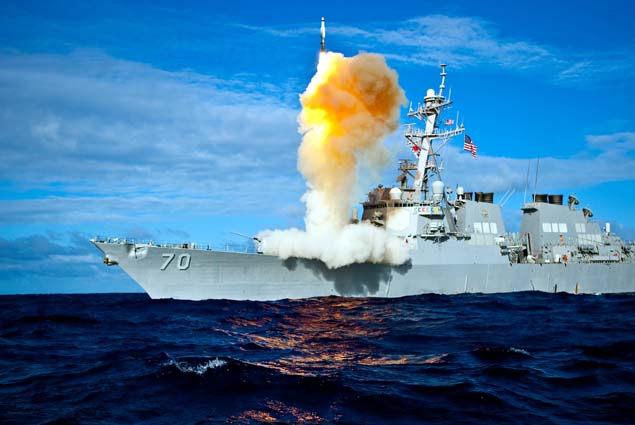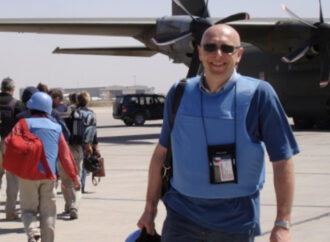
Torpédoborec třídy Arleigh Burke USS Hopper (DDG 70) vybavený systémem Aegis při testu rakety SM-3; Foto U.S. Navy
Administrativa prezidenta Baracka Oabamy urychluje rozmisťování prvků protiraketové obrany v oblasti Perského zálivu. Samozřejmě kvůli Íráncům. „Námluvy“ s prezidentem Ahmanidežádem trvaly necelý rok, aby se zjistilo, že to s tím chlapíkem skutečně nejde, Bush-neBush. Podle listu The New York Times souhlasily nejméně čtyři arabské země v Perském zálivu s rozmístěním baterií Patriotů na svém území, v oblasti rovněž nepřetržitě operují lodě vybavené systémem Aegis amerického námořnictva.
Minulý rok v září jsem se v textu na OWOP ptal, jestli je nějaký plán B, pokud nevyjde sbližování s Íránem. Dodal jsem, že doufám, že to nebude zelená Izraelcům, aby spustili ohňostroj (což by věru nepomohlo vůbec ničemu). To, co se odehrává nyní je takový plán A a 1/2, protože to není plnohodnotná a dlouhodobější strategie, ale takové zadržování všech. Do jisté míry Íránu, ale hlavně Izraele („není důvod útočit, máme všechno pod kontrolou) a spřátelených arabských zemí – což ostatně jsou, pokud jde o Írán, prakticky všechny („není důvod se bát Íránu, máme všechno pod kontrolou“).
Šéf CENTCOMu, generál David Petraeus minulý týden nazval americký přístup v Zálivu moc pěkně: „bi-multi-lateralism“ (další slůvko do učebnic):
The United States works out a shared early warning agreement with a particular country, and then by integrating many bilateral arrangements, we achieve multi-lateral effects. That has actually worked quite well. You see it not only in shared early warning but also in a variety of different ballistic missile defense endeavors in counter-terror activities, a common operational picture, and on and on. You also see it in substantially increased arms sales, frankly, by countries in the region. One country alone, for example, last year I think it was $18 billion. That is a serious amount of investment in a tiny little country who has an air force that is better than the entire Iranian Air Force, I might add. Again, Iran is clearly seen as a very serious threat by those on the other side of the Gulf front, and indeed, it has been a catalyst for the implementation of the architecture that we envision and have now been trying to implement. It also includes, for example, eight Patriot missile boundaries, two in each of four countries, that weren’t there, U.S. Patriot boundaries that weren’t there say two years ago. Other countries have certainly increased their Patriot’s, a whole host of different systems, Aegis ballistic missile cruisers are in the Gulf at all times now.
…partly to take the temperature of the Israeli government and to review both economic and covert programs now under way against the Iranian program, according to officials familiar with the meeting. American officials argue that the willingness of Arab states to take the American emplacements, which usually come with a small deployment of American soldiers to operate, maintain and protect the equipment, illustrates the region’s growing unease about Iran’s ambitions and abilities.
Tance kolem íránského jaderného programu mi připoměly rubriku Think Again v posledním čísle časopisu Foreign Policy. Je tentokrát o jaderných zbraních a John Mueller trefně zpochybňuje tu myriádu obav, které v nás stále vyvolávají. Zvláště po nástupu prezidenta Baracka Obamy, který z nich udělal apokalyptickou hrozbu.
If the Iranians do break their solemn pledge not to develop nuclear weapons (perhaps in the event of an Israeli or U.S. airstrike on their facilities), they will surely find, like all other countries in our nuclear era, that the development has been a waste of time (it took Pakistan 28 years) and effort (is Pakistan, with its enduring paranoia about India and a growing jihadi threat, any safer today?).
To, co Mueller navrhuje se může skutečně zdát kacířské. Pokud se ale člověk zamyslí dvakrát, už tak kacířské mu to přijít nemusí. Respektive dojde k tomu, že stějně moc lepších jiných řešení není:
It is fine to apply diplomacy and bribery in an effort to dissuade those countries from pursuing nuclear weapons programs: We’d be doing them a favor, in fact. But, though it may be heresy to say so, the world can live with a nuclear Iran or North Korea, as it has lived now for 45 years with a nuclear China, a country once viewed as the ultimate rogue. If push eventually comes to shove in these areas, the solution will be a familiar one: to establish orderly deterrent and containment strategies and avoid the temptation to lash out mindlessly at phantom threats.










2 Comments
Jan Havránek
1. 2. 2010, 9:10Posilování protiraketové obrany v Zálivu není nutně obratem v přístupu Obamovy administrativy k Íránu, jak už je koneckonců naznačeno v citátu Davida Petraeuse. Značné investice proudily do zemí „Rady pro spolupráci zemí v oblasti Perského zálivu“ (GCC) už za Bushovy administrativy. Jedná se o natolik zásadní „geopolitické zakázky“, které změna administrativy – a vzhledem k námořní povaze daných komponentů protiraketového systému – ani změna financování těžko ovlivní. Pro dokreslení přidávám citát ze zprávy Institute for Foreign Policy & Analysis, která v roce 2008 zmapovala vývoj v letech 2006-2008 v oblasti protiraketové obrany: „Over the past two years, the members of the six-nation Gulf Cooperation Council (GCC) – Saudi Arabia, Kuwait, Oman, Qatar, Bahrain, and the United Arab Emirates – have begun to explore a range of individual and collective defense options as a response to Iran’s growing ballistic missile capabilities. This has fostered closer cooperation with the United States on the part of several GCC countries,most notably Saudi Arabia, Kuwait, and the United Arab Emirates (UAE), which have shown interest in the PAC-3 system. In December 2007, the U.S. government notified Congress of the possible sale of PAC-3 to Kuwait and the UAE: the UAE requested 288 PAC-3, 216 Guided Enhanced Missiles-T (GEM-Ts), nine Patriot fire units and equipment; Kuwait is seeking 80 PAC-3, GEM-T modification kits to upgrade PAC-2 units and other systems upgrades totaling $1.4 billion. Saudi Arabia has given two contracts to Raytheon totaling more than $100 million for air defense missile systems and other work, including providing technical, training, and logistics support through 2009 for Saudi Patriot and HAWK air defense systems.“ Celá zpráva dostupná zde: http://tinyurl.com/y8quya5.
REPLYFrantišek Šulc
1. 2. 2010, 12:52Jenom drobnost, nemyslim, ze jde o jakykoli „obrat“ (proto plan A a 1/2), chtel jsem zduraznit, ze muj pocit z Obamovy politiky k Iranu je vice nez rozpacity.
REPLY